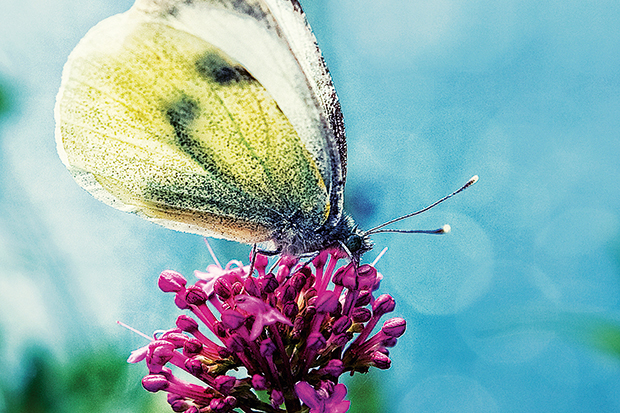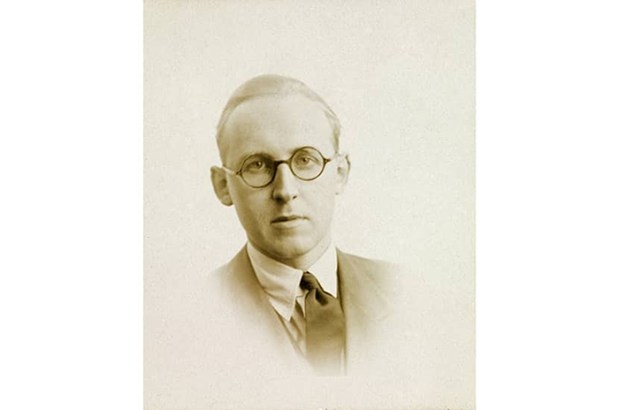Last month, at Edinburgh School of Art, I was interested to come across a student who’d chosen Marlowe’s Dr Faustus as her end-of-year degree project. In the wonderful stage costume she’d designed for its central figure were three gloriously embroidered butterflies fluttering around his hat. Bats, yes, moths, maybe, but what exactly was the significance of butterflies to a man bound for subterranean hell? The answer is in Rainbow Dust, Peter Marren’s superbly distilled statement on our national obsession with butterflies.
It turns out that western civilisation has projected a stream of ideas and meanings on to these creatures that have made them fertile artistic territory for centuries. As metaphors for transient beauty and brief pleasure, they are peculiarly fitting motifs for Marlowe’s tragic character. Yet they can be found making similar moral commentary on human experience in works as varied as Hieronymus Bosch’s ‘Garden of Earthly Delights’ and the kaleidoscope collages of Damien Hirst.
But butterflies are also suggestive of higher human ideals. The ancient Greek name for the insects was the same as their word for soul — ‘psyche’. This was not just a chance association: the adult insect is, after all, a creature that turns from lowly larval ‘worm’ into one of the most beautiful of all life forms. Marren is insightful on all this psychology, but he is equally adept at exploring our scientific investigations of butterflies.
The creatures have been acquired and fetishised by naturalists for centuries. The author is not at all squeamish about the carnage inflicted by early collectors, having begun his own career as a child who killed the things he loved. In fact, he argues for indulgence of this youthful destructive phase because it often blossoms into strong moral feeling. He points out the irony that it is our own hands-off don’t-touch conservation age that has witnessed the greatest losses of butterflies. One cannot help but ponder, however, what lay behind the obsessive appetites of Walter Rothschild, who assembled in the early decades of the 20th century the world’s largest private collection, comprising 2.25 million specimens.
What is most fascinating about Marren’s history of butterfly science is the range of personalities that were devoted to collecting them. My favourite story involves the friendship between Margaret Cavendish-Bentinck, Duchess of Portland, and Jean-Jacques Rousseau. In 1766 they even went butterflying together in the Peak District, where the father of the French Revolution may have had more on his mind than just netting flies. He confessed to the duchess that he was one ‘somewhat savage animal who would live with great pleasure in your menagerie’.
At times that same excited frisson mingles with a whole range of earthier appetites in the impassioned memoir of self-confessed addict Matthew Oates. The author of In Pursuit of Butterflies is the National Trust’s special adviser on all things lepidopteran. Here he has attempted to summarise a lifetime’s fieldwork on Britain’s 60-odd butterfly species. Oates has, in some ways, been both cursed and blessed in the enterprise by his possession of lengthy private diaries.
These casual jottings have allowed him to give an intimate portrait of the period. Unfortunately his blow-by-blow account is largely framed around three basic coordinates: the weather, a rather confusing map of butterfly-rich locations, and his myriad butterfly encounters. The downside of the format is a good deal of repetition and far too much detail. His editor should have been more assertive. Oates compounds the problem with a style that can combine over-florid poetry with a schoolchild’s sense of humour (the Duke of Burgundy fritillary is almost invariably ‘His Grace’, the female of the purple emperor ‘Herself’ or ‘Her Majesty’).
Yet no one can doubt the author’s devotion to these insects and, while he modestly credits the central role played by Martin Warren as leader of the superb organisation Butterfly Conservation, Oates has been a tireless champion in his own right. He also manages, through sheer enthusiasm and extended reminiscence of so much butterfly magic, to conjure the residual enchantment in Britain’s last places of wildlife plenty. Most impressive of all is his concluding chapter, aptly entitled ‘Towards Some Meaning’, where he diagnoses why conservation has so often failed to protect these quintessential inhabitants of ecological transience. He also seeks to answer his own nagging 50-year self-inquiry: why exactly should we care about mere insects?
His answer is simple but telling: ‘The whole show is essentially about love.’ Oates argues that nature conservation ‘is about the relationship between people and nature and is an expression of love for, and an interaction with, the beauty and wonder of the natural world’. The whole essay is one of the best summaries of why nature matters and how we should all care. Its ten pages should be extracted and bound as a pamphlet for every single decision-maker in this country.
Got something to add? Join the discussion and comment below.
Get 10 issues for just $10
Subscribe to The Spectator Australia today for the next 10 magazine issues, plus full online access, for just $10.
'Rainbow Dust', £12.99 and 'In Pursuit of Butterflies', £15.99 available from the Spectator Bookshop, Tel: 08430 600033.
Mark Cocker’s books include A Tiger in the Sand: Selected Writings on Nature, Crow Country and (with Richard Mabey) Birds Britannica.
You might disagree with half of it, but you’ll enjoy reading all of it. Try your first month for free, then just $2 a week for the remainder of your first year.














Comments
Don't miss out
Join the conversation with other Spectator Australia readers. Subscribe to leave a comment.
SUBSCRIBEAlready a subscriber? Log in